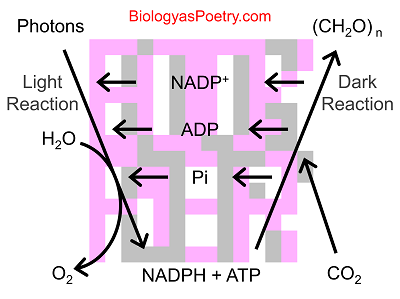Conversion of the of photons into chemical energy stored in chemical bonds.
The process of photosynthesis can be differentiated into light (a.k.a., light-dependent) and dark (a.k.a., light-independent) reactions. It is during the dark reaction that the majority of synthesis occurs whereas it is during the light reaction that photon capture occurs.
The dark reaction in particular uses the energy of photons to synthesize reduced organic molecules, particular sugar as produced photosynthetically by plants, cyanobacteria, and algae. More photosynthesizers, by contrast, lack the dark reaction so only reap the more readily available energy derived from the light reaction (see photoheterotroph).
See also overall reaction of photosynthesis and carbon fixation as well as the carbon cycle.

The chemical bonds formed in photosynthesis most familiarly are those found in carbohydrates. More basically, and particularly in terms of the light reaction, however, the bonds formed are those between ADP and inorganic phosphate, forming ATP, and those between NADP and hydrogen atoms, forming NADPH. It is formation of the latter that is missing in more primitive forms of photosynthesis.
Video (Photosynthesis, the medium picture)